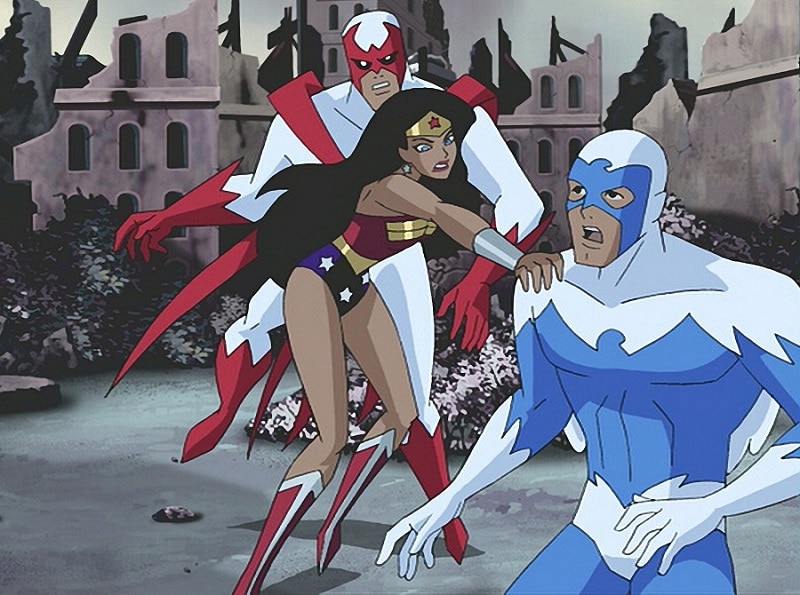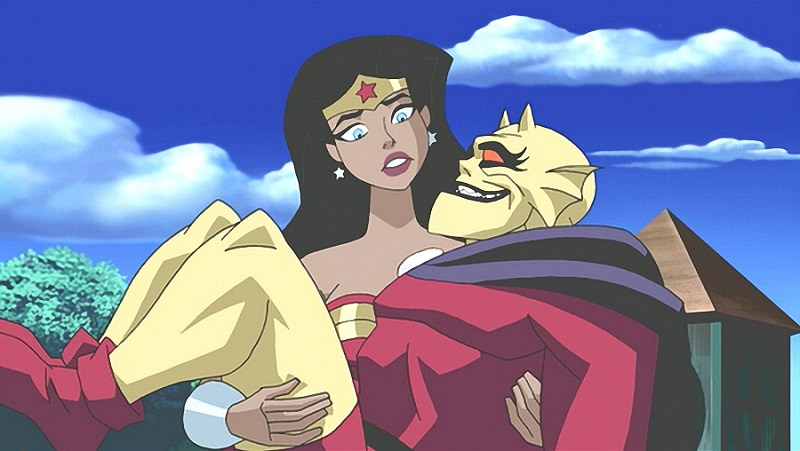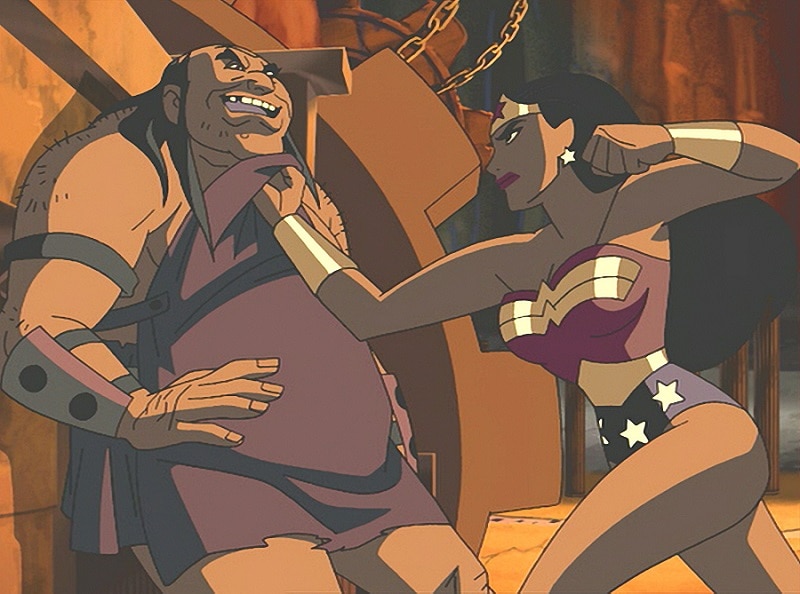If you were a child in the 1990s, like myself, then so much of what informed our shared experience of the DC Universe came from the animated cartoons. For me, personally, this led to my ever-lasting affection for the character of Robin (the Tim Drake version, specifically), and when Justice League debuted I was given my first real and meaningful incarnation of Princess Diana of Themyscira a.k.a. Wonder Woman. Little did I know in my pre-teen brain that this version was about to imprint so hard as to become my definitive Wonder Woman.
Justice League spins out of the success of both Batman and Superman: The Animated Series. Hence, the Dark Knight and the Man of Steel stepping up as not only co-leaders of the greatest super hero team of all time, but also as co-leads of the show. This sometimes means that Wonder Woman isn’t given the chance to step up and take control of the team, but that mirrors the role that she traditionally takes in the comics.
This version of Diana does change her Themysciran origins from what comic book fans might have been used to. Where we are used to reading about Wonder Woman winning an Amazonian competition in order to prove herself the most capable warrior of her people, in Justice League she was the ambassador to “Man’s World.” It’s unclear whether or not this was a tip of the headband to Greg Rucka’s first Wonder Woman run when she was the Themysciran ambassador living in DC, but either way, it makes Diana Prince an exceptional role model for children. Wonder Woman’s intelligence, strength and self-assurance are all qualities that young girls and boys should be instilled with, but when you add Diana Prince’s professional success as an international ambassador, the character becomes proof that all things can be achieved if they are approached with balance and measure. This is something that I’m still striving for in my day-to-day life because Wonder Woman was probably the first fictional example I had of a career woman who was so much more than her job, yet unrestrained by her femininity.
Although Superman—and less often, Batman—was the person giving orders to the Justice League, the show often went out of its way to show Wonder Woman’s leadership capacities on top of her physical strength. There are several episodes where Diana’s classic approach to martial strategy wins the day, or a specific past experience leads to Wonder Woman at the head of the charge. Plus, when you take the body of work between Justice League and Justice League Unlimited into consideration this incarnation of Wonder Woman might even be stronger than Superman. They can go toe-to-toe if needed. In the episode “For the Man Who Has Everything” (based on the classic Superman comic book storyline), when Superman is incapacitated by the Black Mercy, it is up to Diana to spend almost the entire episode in an epic fight with Mongul. Similarly, in “Grudge Match,” Wonder Woman is the ace-up-the-sleeve of her female teammates and easily dispatches all the combatants Roulette sics on her.
Diana is not all brute strength all the time in her most famous cartoon incarnation, however. Justice League does a good job at maintaining her emotional integrity throughout the course of the two series as well. Themyscira is ever present in her mind—like during the events of “Paradise Lost” when she takes down Hades. She maintains a close friendship with Superman, who sometimes manages to soften her more extreme reactions, and there are definite nods at a budding romance between Wonder Woman and Batman, although they are never confirmed to be in a relationship. Batman goes out of his way at one point to describe the differences between them as evidence for him and Wonder Woman to remain strictly platonic, before admitting that they do share something special.

Whether or not Bats/Wondy is your particular ship, it says a lot about Batman that Wonder Woman would consider him potentially worthy of her heart and also speaks well of Diana’s intelligence that she intrigues Bruce. As I mentioned, nothing much ever came of it, but when Justice League and Justice League Unlimited were airing this was a much talked about aspect of Wondy’s character and of the show itself. Steve Trevor is also an important aspect of Diana’s life on the show and they share some of her most emotionally-driven scenes, particularly early on in the series.
No small part of this incredible version of Wonder Woman is due to Susan Eisenberg. Her performance brought both beauty and grace to the character, coupling with fierce emotions. She effortlessly gives these complicated aspects of Princess Diana of Themyscira life, rather than resting on any laurels and giving a—pardon the pun—cartoonish one-dimensional performance. Eisenberg was so good at her job that she is still providing the voice for Wonder Woman in the Injustice video games that are being produced. She holds the record for having played Wonder Woman the longest and will, likely, hold that title for a good long time. This is because Susan Eisenberg is Wonder Woman for me and so many other people all over the world. To us, she is, in many ways, the definitive Wonder Woman and people who were fortunate, like myself, to have grown up with her as our Diana Prince are a very lucky generation of geeks indeed.

I invite you to celebrate Wonder Woman Day this weekend along with me by watching some of the best episodes of Justice League and Justice League Unlimited including “Kid Stuff,” “The Once and Future Thing,” “Hereafter,” “Grudge Match,” “Paradise Lost,” “The Savage Time,” “For the Man Who Has Everything” and “This Little Piggy.”
Ashley V. Robinson writes about Rebirth for DCComics.com and covers The Flash for the #DCTV Couch Club. Look for her on Twitter at @AshleyVRobinson.
Justice League and Justice League Unlimited are both available for streaming on Netflix and Amazon.






















